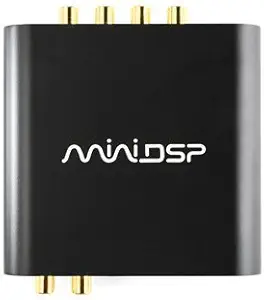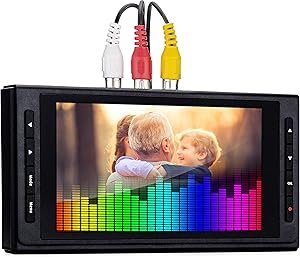Comprehensive review of miniDSP 2×4 HD Digital Audio Signal Processor Features
Comprehensive review of miniDSP 2×4 HD Digital Audio Signal Processor Features
- The audio clarity is exceptional, bringing out intricate details in music and dialogue.
- Compact design fits seamlessly into setups without taking up much space.
- The easy-to-use software interface makes setup and adjustments straightforward.
- Versatile input options like USB, analog, and Toslink accommodate various devices.
As an Amazon Associate I earn from qualifying purchases.
Description
An Audiophile’s Take on the miniDSP 2×4 HD Digital Audio Signal Processor
The miniDSP 2×4 HD, with its compact size and impressive specs, had me intrigued from the moment I unboxed it. As someone who enjoys tinkering with audio setups—whether that’s fine-tuning a home theater system or experimenting with desktop speakers—this digital audio signal processor seemed like a promising addition to my toolkit. It’s more than just another audio gadget; it’s a powerful little box that opens up a world of possibilities.
Design and Build Quality
Looking at the miniDSP 2×4 HD, the first thing I noticed was the sleek, minimalist design. It’s small enough to fit on even the most cluttered desk, measuring only 2 x 10 x 6 inches and weighing a mere 0.317 ounces. Despite its lightweight build, the device feels sturdy and well-constructed. The inclusion of accessories like a remote control, power supply, and USB cable was a nice touch, saving me the hassle of hunting for compatible components.
What really stands out, though, is the intuitive interface software. Setting up the processor didn’t feel overwhelming, even for someone who doesn’t consider themselves an audio engineer. The layout is straightforward, and I appreciated the ability to access all the features without needing to dive into endless menus or manuals.
Key Benefits
The miniDSP 2×4 HD isn’t just about looks—it’s packed with features that cater to audiophiles and casual users alike. Here are some of the winning points I found during my testing:
- Versatile Input and Output Options: With analog, USB, and TOSLINK audio sources available, I had no trouble connecting the processor to various devices, from my desktop PC to my home theater receiver.
- High-Resolution Audio Streaming: The USB audio streaming supports up to 192 kHz, delivering crisp, true-to-life sound.
- Flexible EQ and Crossover Settings: The parametric EQ and Butterworth/Linkwitz-Riley crossovers allowed me to fine-tune every aspect of the audio output.
- Customizable Presets: Having the ability to store up to four unique presets meant I could switch between setups for music, movies, and gaming effortlessly.
- Advanced Processing Power: The onboard 400 MHz Analog Devices SHARC processor brought a noticeable improvement in sound clarity and precision.
Performance and Usability
Once I had the processor integrated into my system, the difference was immediate. The room correction capabilities were particularly impressive. I tested it in a small studio space with uneven acoustics, and the miniDSP 2×4 HD managed to smooth out the sound profile remarkably well. The FIR filter taps added an extra layer of precision to the equalization, making my music sound more balanced and immersive.
Switching between the preset options was a breeze. Whether I was streaming Spotify via USB or watching movies through a TOSLINK connection, the device performed consistently across all inputs. I did geek out a little over the real-time delay adjustment, which made syncing audio to video seamless.
Areas for Improvement
Despite its many strengths, the processor isn’t without its flaws. Here are a few shortcomings I encountered:
- Limited Documentation: While the interface is user-friendly, the provided documentation feels a bit sparse. Beginners might struggle to unlock the full potential of the features without additional resources.
- No Built-In Display: While the software interface is great, having a small on-device display could make basic adjustments quicker.
- Dependent on External Software: The reliance on a PC or laptop for setup means it’s not as plug-and-play as some other devices in its category.
Competing Brands
I’ve had the chance to compare the miniDSP 2×4 HD with other similar products, like the Behringer DCX2496 and the Dayton Audio DSP-408. Both are solid alternatives, but each comes with its own set of trade-offs.
The Behringer model, for instance, offers more comprehensive inputs and outputs, making it ideal for professional setups. However, it’s bulkier and less intuitive for casual users. The Dayton Audio processor, on the other hand, is more affordable but doesn’t quite match the miniDSP’s processing power or software flexibility.
Where the miniDSP 2×4 HD truly excels is its compact design and ease of use. It might not have the extensive I/O options of the Behringer or the budget-friendly appeal of the Dayton, but it strikes a balance that’s hard to beat for home theater enthusiasts and DIY audio fans.
Cost-Effectiveness
When it comes to value for money, the miniDSP 2×4 HD is a solid contender. Sure, it’s not the cheapest option on the market, but the features it offers justify the investment. The high-resolution audio streaming, advanced EQ capabilities, and customizable presets make it a versatile tool that punches well above its weight.
Comparing it to lower-priced alternatives, you’re not just paying for the hardware—you’re also investing in community support. The huge DSP community of DIYers and audio enthusiasts is a treasure trove of tips, tricks, and custom plugins. This adds a layer of longevity and adaptability to the device that cheaper options often lack.
Who Is This For?
The miniDSP 2×4 HD is perfect for anyone looking to take their audio setup to the next level. Whether you’re a home theater enthusiast, a budding sound engineer, or just someone who wants their music to sound better, this processor has something to offer. Its combination of power, flexibility, and ease of use makes it a standout choice in its category.
For those who already have a complex audio system, the processor serves as a valuable tool for fine-tuning and customization. At the same time, its straightforward setup and user-friendly interface make it accessible to newcomers.
Additional information
| Product Dimensions | 2 x 10 x 6 inches |
|---|---|
| Item Weight | 0.317 ounces |
| Item model number | 2×4 HD |
| Is Discontinued By Manufacturer | No |
| Manufacturer | miniDSP |

